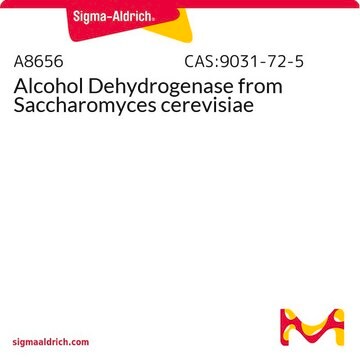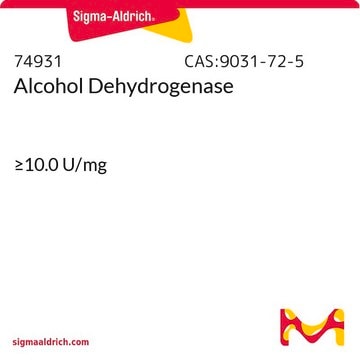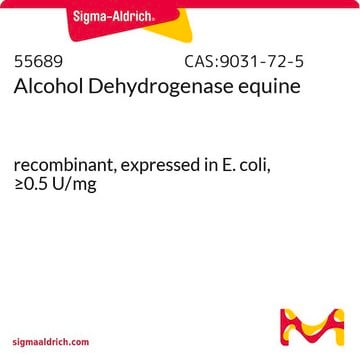A7011
Alcohol Dehydrogenase from Saccharomyces cerevisiae
≥300 units/mg protein, lyophilized powder (contains buffer salts), Mw 141-151 kDa
Sinonimo/i:
ADH1, Adh1p, SCAD, YDAH-1, YIM-1, ADH, Alcohol Dehydrogenase from yeast, Alcohol:NAD+ oxidoreductase
About This Item
Prodotti consigliati
Origine biologica
Saccharomyces cerevisiae
Forma fisica
lyophilized powder (contains buffer salts)
Attività specifica
≥300 units/mg protein
PM
Mw 141-151 kDa
Purificato mediante
crystallization
Condizioni di stoccaggio
(Keep container tightly closed in a dry and well-ventilated place.)
Caratteristiche più verdi
Waste Prevention
Design for Energy Efficiency
Learn more about the Principles of Green Chemistry.
sustainability
Greener Alternative Product
Colore
white to light yellow-brown, Light brown
pH ottimale
8.6-9.0
Solubilità
H2O: soluble 1.0 mg/mL, clear to slightly hazy, colorless to faintly yellow
soluble
N° accesso UniProt
applicazioni
diagnostic assay manufacturing
Categoria alternativa più verde
, Enabling
Condizioni di spedizione
dry ice
Temperatura di conservazione
−20°C
Cerchi prodotti simili? Visita Guida al confronto tra prodotti
Categorie correlate
Descrizione generale
Yeast alcohol dehydrogenase 1 (ADH1) belongs to the family of zinc-containing alcohol dehydrogenases. It is a homotetramer with each subunit containing one catalytic domain and coenzyme-binding domain.
Applicazioni
Ethanol concentration can be determined colorimentrically by monitoring the enzymatic reduction of NAD using alcohol dehydrogenase after preremoval of the aldehyde group.
Azioni biochim/fisiol
Isoelectric point: 5.4-5.8
Optimal pH: 8.6-9.0
Substrates: Yeast ADH is most active with ethanol and its activity decreases as the size of the alcohol increases or decreases. Branched chain alcohols and secondary alcohols also have very low activity.
KM (ethanol) = 2.1 × 10-2 M
KM (methanol = 1.3 × 10-1 M
KM (isopropanol) = 1.4 × 10-1 M
Inhibitors: Compounds that react with free sulfhydryls, including N-alkylmaleimides and iodoacetamide.
Zinc chelator inhibitors, including 1,10-phenanthroline,
8-hydroxyquinoline, 2,2′-dipyridyl, and thiourea.
Substrate analogue inhibitors, including β-NAD analogs, purine and pyrimidine derivatives, chloroethanol, and fluoroethanol.
Extinction Coefficient: E1% = 14.6 (water, 280 nm)
Avvertenza
Definizione di unità
Stato fisico
Nota sulla preparazione
Anticorpo
Codice della classe di stoccaggio
11 - Combustible Solids
Classe di pericolosità dell'acqua (WGK)
WGK 3
Punto d’infiammabilità (°F)
Not applicable
Punto d’infiammabilità (°C)
Not applicable
Dispositivi di protezione individuale
Eyeshields, Gloves, type N95 (US)
Certificati d'analisi (COA)
Cerca il Certificati d'analisi (COA) digitando il numero di lotto/batch corrispondente. I numeri di lotto o di batch sono stampati sull'etichetta dei prodotti dopo la parola ‘Lotto’ o ‘Batch’.
Possiedi già questo prodotto?
I documenti relativi ai prodotti acquistati recentemente sono disponibili nell’Archivio dei documenti.
I clienti hanno visto anche
Protocolli
To measure alcohol dehydrogenase activity, this assay uses β-nicotinamide adenine dinucleotide phosphate and a continuous spectrophotometric rate determination at 340 nm.
Il team dei nostri ricercatori vanta grande esperienza in tutte le aree della ricerca quali Life Science, scienza dei materiali, sintesi chimica, cromatografia, discipline analitiche, ecc..
Contatta l'Assistenza Tecnica.








